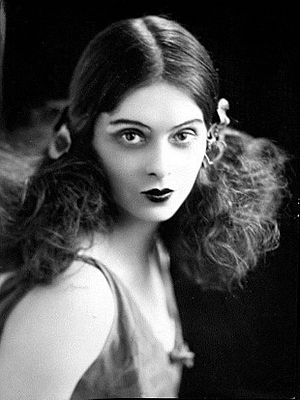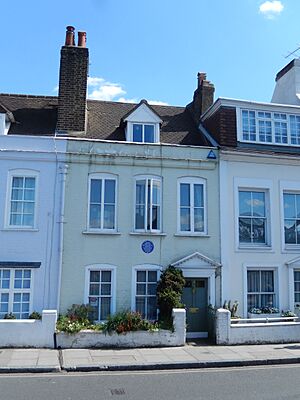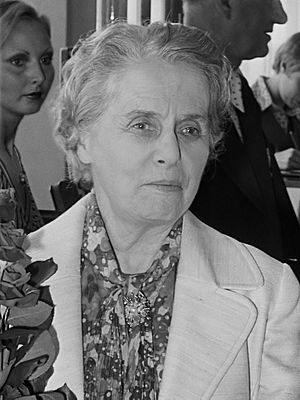Ninette de Valois facts for kids
Quick facts for kids
Ninette de Valois
|
|
|---|---|

de Valois (c. 1920s)
|
|
| Born |
Edris Stannus
6 June 1898 |
| Died | 8 March 2001 (aged 102) Barnes, London, England, UK
|
| Nationality | British |
| Citizenship | British |
| Education |
|
| Occupation |
|
| Years active | 1900s–1990s |
| Organization |
|
| Known for | Ballet |
|
Notable work
|
|
| Title | Founder and Artistic Director |
| Term | 1931–1963 (Royal Ballet) |
| Predecessor | None (Founder) |
| Successor | Sir Frederick Ashton |
| Spouse(s) |
Arthur Blackall Connell
(m. 1935; died 1987) |
| Awards |
|
Dame Ninette de Valois (born Edris Stannus; 6 June 1898 – 8 March 2001) was an amazing Irish-born British dancer, teacher, choreographer, and director. She is most famous for dancing with Serge Diaghilev's Ballets Russes. Later, she created The Royal Ballet, which became one of the world's top ballet companies. She also started the Royal Ballet School and the touring company that is now the Birmingham Royal Ballet. Many people see her as one of the most important figures in ballet history. She's often called the "godmother" of English and Irish ballet.
Life Story
Early Years and Training
Ninette de Valois was born as Edris Stannus on 6 June 1898. Her home was Baltyboys House in Blessington, County Wicklow, Ireland. In 1905, when she was seven, she moved to England.
She began taking ballet lessons in 1908, at the age of ten. When she was thirteen, she started her professional training at the Lila Field Academy for Children. Around this time, she changed her name to Ninette de Valois. She made her first professional appearance as a main dancer in a pantomime show in London.
Dancing with the Stars
In 1919, at 21, Ninette became a principal dancer for the Beecham Opera. She kept learning from famous ballet teachers like Edouard Espinosa, Enrico Cecchetti, and Nicholas Legat.
In 1923, de Valois joined the Ballets Russes. This was a very famous ballet company started by Sergei Diaghilev. She danced with them for three years, performing all over Europe. She became a "Soloist" and helped create roles in famous ballets like Les biches. She also helped Alicia Markova, who was a child at the time and later became a very famous English dancer. De Valois said she learned everything about running a ballet company from Diaghilev. In 1924, she stopped intense dancing because of an old injury from childhood polio.
Building Ballet Schools
After leaving Ballets Russes in 1927, de Valois opened her own dance school in London. She also started the Abbey Theatre School of Ballet in Dublin. Her main goal in London was to create a ballet company. This company would use dancers trained in a special British ballet style from her school.
Her students gained experience by performing in operas and plays at the Old Vic Theatre. De Valois choreographed many short ballets for these shows. In 1931, she moved her school to the newly reopened Sadler's Wells Theatre. It was renamed the Sadler's Wells Ballet School. A ballet company, called the Vic-Wells Ballet, was also formed. These became the foundations for today's The Royal Ballet, Birmingham Royal Ballet, and Royal Ballet School.
In Dublin, poet William Butler Yeats asked de Valois to start a ballet school. She took charge of the Abbey Theatre School of Ballet in November 1927. This school ran until 1933 and helped many dancers.
Creating New Ballets
During these years, de Valois created many ballets each year. Most of them were choreographed by her. She also worked with Irish composers to create new music for her ballets. Some examples include The Faun (1928) and The Drinking Horn (1933).
The Vic-Wells Ballet Grows
When it first started, the Vic-Wells Ballet had only six female dancers. De Valois was the lead dancer and choreographer. Their first full ballet performance was on 5 May 1931. As the company became successful, de Valois hired more dancers and choreographers. She stopped dancing herself in 1933, after Alicia Markova joined and became the main ballerina.
Under de Valois's leadership, the company grew a lot in the 1930s. It became one of the first Western companies to perform classic ballets from the Imperial Russian Ballet. She also wanted to create a unique British style. She hired Frederick Ashton as the main choreographer and Constant Lambert as the music director in 1935. She also choreographed her own famous ballets like Job (1931), The Rake's Progress (1935), and Checkmate (1937).
The company eventually included many of the world's most famous ballet dancers. These included Margot Fonteyn, Robert Helpmann, and Michael Somes. In 1949, the Sadler's Wells Ballet was a huge hit when they toured the United States. Fonteyn became an international star instantly.
In 1947, de Valois also started the first ballet school in Turkey. This school later became part of the Hacettepe University in Ankara.
The Royal Ballet is Born
In 1956, Queen Elizabeth II gave the ballet company and school a special Royal Charter. This officially linked them together. De Valois made sure her company always had new talented dancers. Later, stars like Rudolf Nureyev joined. She also invited famous choreographers like Sir Kenneth MacMillan and George Balanchine to work with her company.
She officially retired as director of the Royal Ballet in 1963. However, she continued to have a big influence on the company and the school. She formally retired from the school in 1970. De Valois also supported other ballet projects in Ireland.
Helping Turkish Ballet Grow
De Valois had a big impact on ballet in Turkey, where ballet was not well known before. The Turkish government asked her to help set up a ballet school there. She visited Turkey in the 1940s and opened a school similar to her Sadler's Wells Ballet School in London. This led to the creation of the Turkish State Opera and Ballet.
After training the first students, de Valois helped the Turkish State Ballet with early performances. She allowed Royal Ballet dancers like Margot Fonteyn to perform as guests. She put on traditional ballets like Coppélia and Swan Lake. She also staged her own ballets like The Rake's Progress.
In 1965, de Valois created the first full-length ballet for the new Turkish State Ballet. It was called Çeşmebaşı (At the Fountain). This ballet used music by a Turkish composer and included Turkish folk dance moves. Today, ballet is very popular in Turkey, and the school de Valois started is part of the State Conservatory.
Personal Life
In 1935, Ninette de Valois married Dr. Arthur Blackall Connell, a doctor and surgeon. They lived in Barnes, London. She kept her private life very separate from her work. She made very few mentions of her marriage in her writings.
In 1964, she was featured on the TV show This Is Your Life. She continued to appear in public until she passed away in London at the age of 102. In 1991, she was on BBC Radio 4's Desert Island Discs. She chose a book of poems and a bottle of sleeping pills as her luxury item.
Famous Choreography
De Valois first became known as a choreographer by creating short ballets for the Old Vic Theatre in London. Her students performed these. After starting the Vic-Wells Ballet, her first major work was Job (1931). This ballet was very important for shaping the future of British ballet.
Later, she worked with Frederick Ashton, the company's first main choreographer. Together, they created many important ballets that are now cornerstones of British ballet. These include The Rake's Progress (1935) and Checkmate (1937).
Job (1931)
Job is the oldest ballet still performed by the Royal Ballet. It was a key work in developing British ballet. It was also the first ballet created entirely by a British team. De Valois choreographed and produced it. The music was written by Ralph Vaughan Williams, and the designs were by Gwen Raverat.
The story of the ballet comes from the Book of Job in the Hebrew Bible, inspired by drawings by William Blake. The ballet has eight scenes. De Valois used mostly mimed actions to create a simple, artistic look.
Even though some parts of the choreography have been called "uneven," Job has many well-known dances. These are still performed regularly. The most famous parts are Satan's Dance (an acrobatic solo for a male dancer) and the dances of Job's comforters. Job first premiered on 5 July 1931 in London. The first public performance was on 22 September 1931.
Other Works
Ninette de Valois also choreographed these ballets:
- The Haunted Ballroom (1934)
- Bar aux Folies-Bergère (1934)
- The Rake's Progress (1935)
- As You Like It (1936)
- Checkmate (1937)
- Every Goose Can
- The Gods Go A-Begging
- Barabau
- The Prospect Before Us (1940)
- Keloğlan (1950)
- At the Fountain Head (1963)
- Çeşmebaşı (1965), for the Turkish State Opera and Ballet
- Sinfonietta (1966)
- Coppèlia
Awards and Recognition
Special Honours
Ninette de Valois received many important honours for her work. She was made a Commander of the Order of the British Empire (CBE) in 1947. Then, she became a Dame Commander (DBE) in 1951, which means she was given the title "Dame."
She also became a Member of the Order of the Companions of Honour (CH) in 1981. In 1992, Queen Elizabeth II gave her the Order of Merit (OM), which is a very special award.
France also recognized her, making her a Knight of the Legion of Honour in 1950. In 1998, she received the Order of Merit of the Republic of Turkey.
Other Awards
Ninette de Valois received many awards for her contributions to ballet. In 1949, she got a Bronze award from the Irish Catholic Stage Guild. She was the first person to receive the Royal Academy of Dance Queen Elizabeth II Coronation Award in 1953–1954.
In 1964, she received the Royal Society of Arts Albert Medal. In 1974, she was given the Praemium Erasmianum Foundation Erasmus Prize. She also received the Queen Elizabeth II Silver Jubilee Medal in 1977 and a Long Service medal from the Royal Opera House in 1979.
In 1989, she won the Critics' Circle Award for her great service to the arts. In 1992, she received a special Laurence Olivier Award. In the United States, she received the Dance Theatre of Harlem Emergence Award in 1981.
Honorary Degrees
Ninette de Valois received many honorary degrees from universities. These degrees are given to people who have achieved great things, even if they didn't study at that university. She received Doctor of Music (DMus) degrees from the University of London (1947), the University of Sheffield (1955), Trinity College Dublin (1957), and Durham University (1982).
She also received Doctor of Letters (DLitt) degrees from the University of Reading (1951), the University of Oxford (1955), and the University of Ulster (1979). In 1958, she received an LLD from the University of Aberdeen, and in 1975, a Doctor of Letters from the University of Sussex.
See also
 In Spanish: Ninette de Valois para niños
In Spanish: Ninette de Valois para niños
- Category:Ballets by Ninette de Valois
- List of people on stamps of Ireland
- Women in dance
- Legion of Honour
- List of Legion of Honour recipients by name (V)
- Legion of Honour Museum



